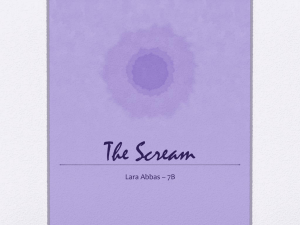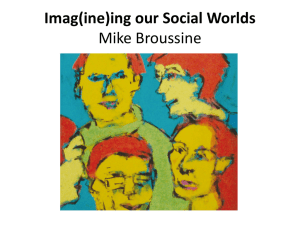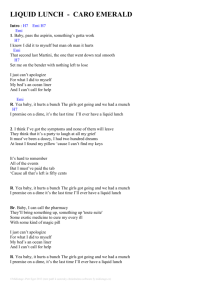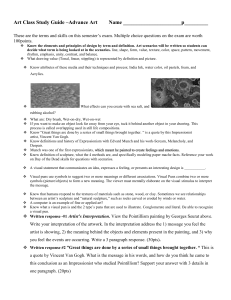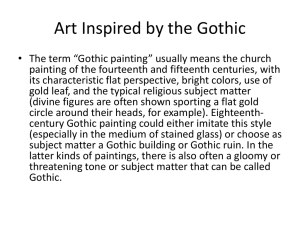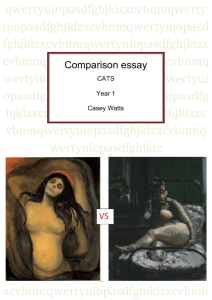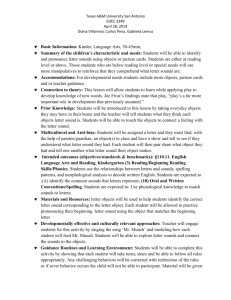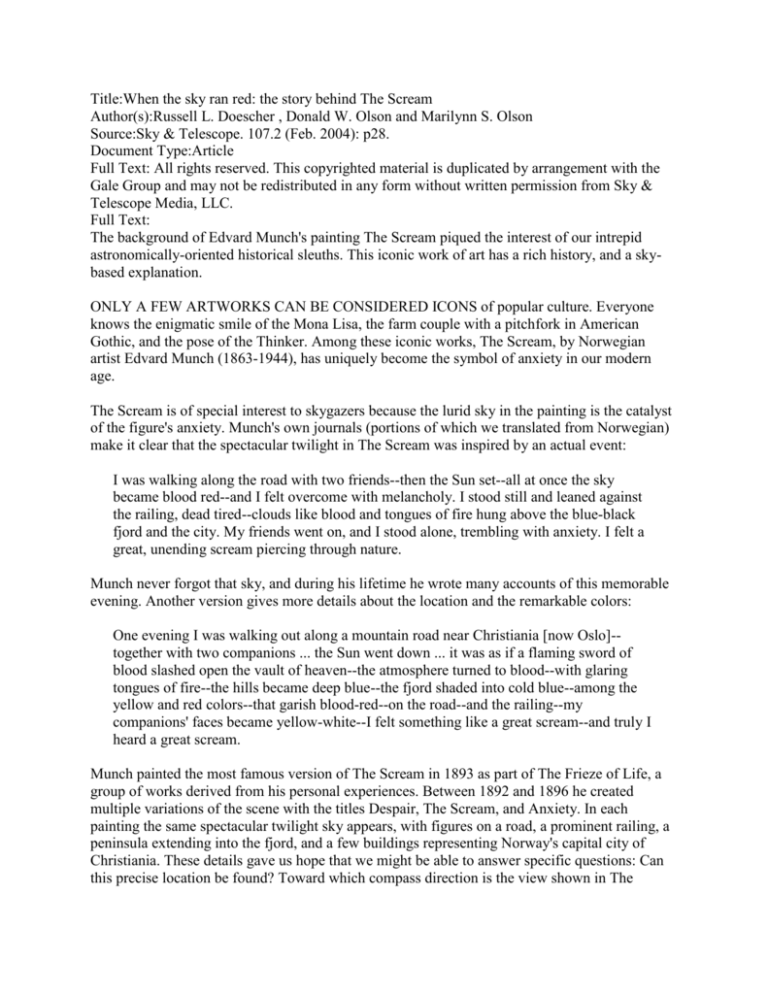
Title:When the sky ran red: the story behind The Scream
Author(s):Russell L. Doescher , Donald W. Olson and Marilynn S. Olson
Source:Sky & Telescope. 107.2 (Feb. 2004): p28.
Document Type:Article
Full Text: All rights reserved. This copyrighted material is duplicated by arrangement with the
Gale Group and may not be redistributed in any form without written permission from Sky &
Telescope Media, LLC.
Full Text:
The background of Edvard Munch's painting The Scream piqued the interest of our intrepid
astronomically-oriented historical sleuths. This iconic work of art has a rich history, and a skybased explanation.
ONLY A FEW ARTWORKS CAN BE CONSIDERED ICONS of popular culture. Everyone
knows the enigmatic smile of the Mona Lisa, the farm couple with a pitchfork in American
Gothic, and the pose of the Thinker. Among these iconic works, The Scream, by Norwegian
artist Edvard Munch (1863-1944), has uniquely become the symbol of anxiety in our modern
age.
The Scream is of special interest to skygazers because the lurid sky in the painting is the catalyst
of the figure's anxiety. Munch's own journals (portions of which we translated from Norwegian)
make it clear that the spectacular twilight in The Scream was inspired by an actual event:
I was walking along the road with two friends--then the Sun set--all at once the sky
became blood red--and I felt overcome with melancholy. I stood still and leaned against
the railing, dead tired--clouds like blood and tongues of fire hung above the blue-black
fjord and the city. My friends went on, and I stood alone, trembling with anxiety. I felt a
great, unending scream piercing through nature.
Munch never forgot that sky, and during his lifetime he wrote many accounts of this memorable
evening. Another version gives more details about the location and the remarkable colors:
One evening I was walking out along a mountain road near Christiania [now Oslo]-together with two companions ... the Sun went down ... it was as if a flaming sword of
blood slashed open the vault of heaven--the atmosphere turned to blood--with glaring
tongues of fire--the hills became deep blue--the fjord shaded into cold blue--among the
yellow and red colors--that garish blood-red--on the road--and the railing--my
companions' faces became yellow-white--I felt something like a great scream--and truly I
heard a great scream.
Munch painted the most famous version of The Scream in 1893 as part of The Frieze of Life, a
group of works derived from his personal experiences. Between 1892 and 1896 he created
multiple variations of the scene with the titles Despair, The Scream, and Anxiety. In each
painting the same spectacular twilight sky appears, with figures on a road, a prominent railing, a
peninsula extending into the fjord, and a few buildings representing Norway's capital city of
Christiania. These details gave us hope that we might be able to answer specific questions: Can
this precise location be found? Toward which compass direction is the view shown in The
Scream? When did Munch and his two friends walk along the road? What did Munch see in the
sky?
What Year and Season?
In his 1972 monograph entirely devoted to The Scream, Reinhold Heller states that unusually
colorful sunsets are "visible in Oslo ... in the late months of autumn.... As the sun then sets, it
shines onto the clouds ... and transforms them into stripes and tongues of intense reds and
yellows in the blue sky. The phenomenon is an extremely impressive one, as unforgettable as it
is indescribable." Aware that one of Munch's prose accounts about the red sky was written on
January 22, 1892, Heller judged that the original experience occurred shortly before, in the fall of
1891.
A recent BBC documentary about The Scream adopts the same explanation. A companion book
to the program, The Private Life of a Masterpiece, by Monica Bohm-Duchen (2001), notes that
"red and yellow wave-like clouds are a climatic peculiarity of northern Europe, and were
frequently painted by artists from the north" and agrees that the event occurred "probably in
1891" during "late autumn."
At the other extreme, Thomas M. Messer argues in his 1973 study of Munch that "nothing
external gives a clue to the horror that impels the outcry" and observes that the "bandlike
arrangements that lend intensity and swirling motion to the composition as a whole have often
been identified as visualizations of sound waves" but alternately could be "externalizations of
force and energy."
These explanations didn't seem adequate to us. Messer seems to imply that Munch's experience
was entirely internal and psychological, yet Munch's written accounts say that a blood-red sky
preceded his melancholy and triggered the scream. Moreover, Munch attached great importance
to this unusually spectacular twilight, but the sunsets as described by Heller would occur fairly
often, perhaps every autumn.
We began by searching astronomical and meteorological records from the period just prior to
January 22, 1892, looking (without success) for the impressive event that could have so
dramatically affected Munch. But as we learned more about Munch, we realized that the original
experience with the twilight sky could have been much earlier. In fact, many paintings created in
the 1890s for The Frieze of Life were inspired by events from years before, as recorded in his
diaries and notebooks. For example, Munch's beloved sister Sophie died in 1877. The artist
depicted this tragic scene in a series of works titled Death in the Sickroom in 1893--fully 16
years afterward. We wondered whether this pattern of an autobiographical event painted much
later held true for The Scream. We found support for this idea in a book by Arne Eggum, former
chief curator of the Munch Museum, who disagrees with Heller and prefers the summer of 1886
as the probable date for Munch's walk along the mountain road (Livsfrisen Fra Maleri Til
Grafikk, 1990).
There is other evidence suggesting that the Scream event occurred considerably earlier. During a
stay in Nice in the winter of 1891-92, Munch discussed art with his friend Christian Skredsvig,
who wrote:
For a long time he had wanted to paint the memory of a sunset. Red as blood. No, it was
coagulated blood. But no one else would perceive it the same way he did. They would think only
about clouds. He talked himself sick of this sight that had gripped him with terror. With sadness,
because the paltry resources of painting were not adequate. "He is striving after the impossible
and has despair as his religion," I thought, but I advised him to paint it--and so he painted his
remarkable "Scream."
In recalling his time spent in Nice, Munch himself explicitly mentioned the years of the original
inspirations for three of the paintings in The Frieze of Life:
... the first Scream ... Kiss ... Melancholy.... For these a number of rough sketches had
already--in 1885-89--been done in that I had written texts for them--more correctly said,
these are illustrations of some memoirs from 1884....
The Bohemian Days of the 1880s
Munch helped to date the origin of The Scream in another way in a letter to his friend Jens Thiis:
"You don't have to go so far in order to explain the genesis of The Frieze of Life--its explanation
lies in the bohemian time itself."
Although Munch's connection to the bohemian community of artists and writers is well
documented for 1884, the bohemian days of his memory can plausibly originate in the second
half of the previous year, when Munch was sharing a studio in Christiania with six other young
artists. It was in 1883 that Munch exhibited his paintings publicly for the first time at the Art and
Industry Exhibition during the summer and the Fall Exhibition in December.
Moreover, Munch almost certainly attended the wildly controversial Christiania premiere of
Henrik Ibsen's play Ghosts on October 17, 1883. The play, which contrasted the honest, free life
of the bohemian artists to the hypocritical conventionality of Norwegian society, polarized the
capital. Eggum notes that Munch painted a portrait of one of his friends in the characteristic pose
of the bohemian, Osvald, in the play.
But this eventful season for artists was also a lively time for skywatchers, and we now realized
that science could explain the blood-red sky in The Scream. The end of 1883 and the first months
of 1884 had the most spectacular twilights of the last 150 years!
A Volcanic Solution
The volcanic island of Krakatoa in Indonesia erupted in a cataclysmic explosion on August 27,
1883, sending dust and gases high into the atmosphere. Magnificent fiery sunsets and sunrises
resulted, first in the Southern Hemisphere, then near the equator, and eventually in northern
latitudes, as the cloud of volcanic aerosols spread worldwide in the following months.
A report issued by the Royal Society in London devoted more than 300 pages to "Unusual
Optical Phenomena of the Atmosphere," with a section collecting the "Descriptions of the
Unusual Twilight Glows in Various Parts of the World, in 1883-4."
We also checked newspapers and scientific journals from this period and found hundreds of
accounts from astonished observers worldwide. The effects had reached New York by November
28, 1883, as reported in the New York Times:
Soon after 5 o'clock the western horizon suddenly flamed into a brilliant scarlet, which
crimsoned sky and clouds. People in the streets were startled at the unwonted sight and gathered
in little groups on all the corners to gaze into the west. Many thought that a great fire was in
progress.... People were standing on their steps and gazing from their windows as well as from
the streets to wonder at the unusual sight. The clouds gradually deepened to a bloody red hue,
and a sanguinary flush was on the sea....
Colored stripes and bands in the sky, like those later painted in The Scream, appeared to
Pennsylvania residents, who
... witnessed a most beautiful and startling phenomenon in the eastern heavens.... The sky
that morning was fairly aglow with crimson and golden fires, when suddenly, to their
great astonishment, an immense American flag, composed of the national colors, stood
out in bold relief high in the heavens, continuing in view for a considerable length of
time.
(Hanover Spectator, December 19, 1883)
In England, the journal Nature published a lengthy series of reports about the "remarkable
sunsets" beginning in December 1883. Newspapers printed dozens of letters with descriptions
like the following:
The sunset last evening at Eastbourne surpassed anything of the kind seen on the south coast.
The sky changed from a pale orange to a blood red, and it seemed as if the sea itself were one
mass of flames. (Times of London, November 29, 1883)
William Ascroft, an especially diligent English observer of the twilights, concluded that the
"finest occurred midwinter 1883-84, when some deepened into the richest crimson, and were
known as 'Blood Afterglows.'" The English poet Alfred, Lord Tennyson, remembered this season
and later used the image:
Had the fierce ashes of some fiery peak
Been hurl'd so high they ranged about the globe?
For day by day, thro' many a blood-red eve ...
The wrathful sunset glared....
But could Munch have seen the Krakatoa twilights at Christiania's high northern latitude? The
reports collected by the Royal Society in London show that the unusual twilight glows appeared
in Norway from late November 1883 through the middle of February 1884. At the end of
November, astronomers Carl Fredrik Fearnley and Hans Geelmuyden at Christiania Observatory
first noticed the "very intense red glow that amazed the observers" and developed into a "red
band." The spectacle was clearly widely seen, as Christiania's daily paper reported on November
30th:
A strong light was seen yesterday and today around five o'clock to the west of the city.
People believed it was a fire: but it was actually a red refraction in the hazy atmosphere
after sunset.
When Lunar Eclipses Go Dark
Krakatoa's optical effects have not been equaled in the last 120 years, but observations after
some recent volcanic eruptions have given us an idea of what the skies must have been like in
1883-84.
Readers may recall the colorful twilights of 1991-92 and the very dark lunar eclipse on
December 9-10, 1992, following the eruption of Mount Pinatubo in the Philippines. Sky &
Telescope's volcano expert, Stephen James O'Meara, has noted that when a lunar eclipse occurs
soon after a major volcanic eruption, the Moon can appear unusually dark. High concentrations
of volcanic aerosols make the Earth's atmosphere more opaque to sunlight passing through, and
less light refracts into the Earth's shadow (S&T: April 1993, page 107).
The lunar eclipse of December 30, 1982, and the red twilights seen in that year were similarly
affected by the volcano El Chichon in Mexico (reported in the March and April 1983 issues).
And veteran skywatchers may remember the lunar eclipse of December 30, 1963, darkened by
aerosols from the eruption of Mount Agung in Indonesia.
Following the Krakatoa explosion, astronomers likewise reported to Nature that during the total
lunar eclipse of October 4, 1884, "the obscuration of the moon was carried to a degree far
beyond anything witnessed in the eclipses of recent times," and "the density and blackness of the
shadow was far greater than any previous one that I had seen...."
Visiting Norway
If volcanic aerosols from Krakatoa colored the skies when Munch and his friends took their
walk, then the date of this experience must have been between the end of November 1883 and
the middle of February 1884, therefore near the winter solstice. Such a view of a Krakatoa sunset
must have been toward the southwest.
We traveled to Oslo in May 2003 in part to examine documents from Munch's bohemian days in
the archives at the Munch Museum and the National Library. To determine the direction of the
view shown in The Scream, we also spent several days hiking in the hills near Oslo to find the
precise location where Munch and his friends were walking when he saw the blood-red sky.
We wanted to compare the topographic features of Oslo with Munch's artwork. But since we
were interested in the location of Munch's original experience, rather than how he reworked the
motif, we knew that one drawing in particular was the most important for this purpose. Art
historians agree that this sketch (cataloged as T126 p. 10 R) is the initial study for the first
version of Despair, which Munch called "the first Scream." As shown on page 35, this drawing
contains specific details: a cliff on the left, a road with a railing turning left and descending
beyond the cliff, and, in the fjord, an island with a prominent round hill. Ship masts extend above
the horizon, showing that Munch's viewpoint for the drawing had a rather low elevation, less
than 30 meters (100 feet) above the water level.
All of the later painted versions, including the most famous Scream, have a much higher
viewpoint, looking down to small and distant ships in the harbor below, with the city suggested
on the right.
So we were actually searching for two locations--with the lower location the more important one
because the original experience occurred there. During our visit in Oslo we found both the lower
and upper viewing locations on the slopes of a 142-meter-high hill called the Ekeberg.
The upper location is a viewpoint on a rocky ledge 128 meters above the harbor. From this spot,
we could see the Akershus peninsula extending into the fjord, as well as the spire of Vor Frelser's
Church and the dome of Trinity Church, buildings Munch used to indicate the city skyline.
Baedeker tourist guides from the late 19th century specifically advised visitors to "ascend the
stony old road ... pass the farm of Ekeberg, and follow a field-road." After five minutes, one
would leave the road and walk "to the right for a few hundred paces to a rocky platform
affording a fine view of the town and harbour." This panorama was illustrated on dozens of
postcards and lantern slides from that time.
Although the view toward the fjord is generally toward the west and southwest, this upper
location cannot be the precise spot where Munch saw the red twilight and "leaned against the
railing, dead tired." The Baedeker maps, along with other early maps that we examined at the
Oslo city museum, make it clear that no road (and railing) reached this overlook. (About 140
meters east of the rocky ledge, modern visitors will find a Scream historic marker and metal
railings on a horseshoe bend of a road called Valhallveien, but this horseshoe bend did not exist
in the 19th century. The rocky ledge can still be reached by hiking to the northwest slope of the
hill, now rather overgrown by trees.)
The lower viewpoint, the one employed for Munch's first sketch, is on a road that wraps around
the western slope of the Ekeberg hill. The street, now called Mosseveien, appears on the 19thcentury maps with the name Ljabrochausseen. Art historian Frank Hoifodt helped us find a 19thcentury photograph showing Ljabrochausseen bordered by railings exactly like those drawn and
painted by Munch. The road is only 15 meters above the water level, and dockside cranes now
extend above the horizon much as the ship masts do in Munch's drawing.
On the Spot
By studying the perspective of the cliff and the distinctive round hill on Hovedo island, we could
determine Munch's position with remarkable precision, within a few meters. This viewpoint is
100 meters from the modern tunnel portals where the E6 motorway passes through the Ekeberg
hill, measured in the direction toward the intersection where Mosseveien joins with the E18
motorway. From this spot, Munch's direction of view in the drawing was toward the southwest-exactly where the Krakatoa twilights appeared in the winter of 1883-84.
Munch's own words, along with our topographic results, provide strong evidence that these
blood-red afterglows are the connection between one of the world's most famous volcanoes and
one of the world's most famous paintings!
Artists and astronomers may look at the sky in different ways, and few of us would perceive a
volcanic sunset with the same state of mind that Munch brought to it. But we, like Munch, have
experienced extraordinary sky phenomena and associated them in memory with our situation and
our lives. We know that our lives are richer because we pay attention to what the skies offer. In
this way, we have an inside connection to one of the world's most famous images.
DON OLSON and RUSSELL DOESCHER teach in the physics department, and Marilynn Olson
in the English department, at Texas State University (formerly called Southwest Texas State
University). The authors have previously written about the skies in three paintings by Vincent
van Gogh in articles that have appeared in Sky & Telescope: in October 1988, April 2001, and
July 2003.
The authors are grateful for research assistance from Margaret Vaverek at Texas State
University's Alkek Library, the American-Scandinavian Foundation, the staffs at the Oslo
Bymuseum and the National Library of Norway, and Lasse Jacobsen and Frank Hoifodt at the
Munch Museum in Oslo.
Abstract:
A walk at sunset instilled Norwegian artist Edvard Munch to put his feelings to canvas The
Scream the most famous version and one of the most widely recognized works of art. The
background of the painting vexed the interest of some of the astronomically oriented historical
sleuths, as this work has a rich history and a sky-based explanation.
Source Citation
Doescher, Russell L., Donald W. Olson, and Marilynn S. Olson. "When the sky ran red: the story
behind The Scream." Sky & Telescope Feb. 2004: 28+. Academic OneFile. Web. 20 Aug. 20


